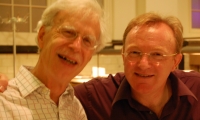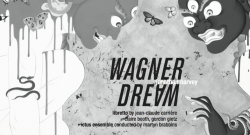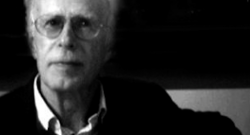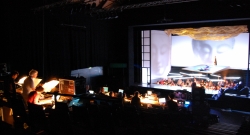Music
Jonathan Harvey
Libretto
Jean-Claude Carrière
>Full CD on Youtube
>Read the libretto, ENG | NL | FR
Stage direction: Pierre Audi
Conductor: Martyn Brabbins
Stage and light : Jean Kalman
Costumes : Robby Duiverman
IRCAM Computer Music Designer :
Gilbert Nouno
Interludes Computer Music Designers :
Carl Faia, Gilbert Nouno
Ensemble: Ictus
Michael Schmid, flutes and piccolo | Piet Van Bockstal, oboe | Dirk Descheemaeker and Benjamin Dieltjens, clarinets and bass clarinets | Bert Helsen, bassoon | Kaat Chiers, horn | Philippe Ranallo, trumpet | Alain Pire, trombone | Robin Hayward, tuba | Jean-Luc Plouvier, keyboards | Gerrit Nulens and Michael Weilacher, percussion | Samia Bousbaine, harp | George van Dam, Igor Semenoff, David Nunez and Marieke Berendsen, violins | Paul De Clerck and Jeroen Robbrecht, violas | Geert De Bièvre and François Deppe, cellos | Géry Cambier, double bass
Claire Booth, Prakriti
Gordon Gietz, Ananda
Matthew Best, Vairochana
Dale Duesing, Buddha
Rebecca de Pont Davies, Mother
Richard Angas, Old Brahmin
Johan Leysen, Wagner
Catherine ten Bruggencate, Cosima
Charles Hens, Jungling
Commissioned & produced by
De Nederlandse Opera (Amsterdam), le Grand Théâtre de la Ville de Luxembourg, Holland Festival, IRCAM-Centre Pompidou
A coproduction of
De Nederlandse Opera (Amsterdam), Grand Théâtre (Luxembourg), Ircam (Paris) and Holland Festival (Amsterdam)
Creation
April 2007 in Grand Théâtre, Luxemburg (in the programme of Luxemburg Cultural Capital of Europe 2007), then also presented by Holland Festival, Amsterdam (June 2007) and by Ircam, Paris (June 2007)
At the heart of this opera...
At the heart of this opera is the clash of two cultures. Late, highly charged romanticism with its paradigm of finding knowledge through emotional intensity fused with deep psychology and mythic regression, on the one hand. And on the other hand the new and old world of Buddhism and oriental thought with its detachment, its clear analysis of happiness and suffering in terms of mind. Perhaps this latter is the future, and the Wagner world is what we are coming from. John Cage comes after Wagner…
It is an interesting fact that Wagner, most egotistical and most complex of men, was yet one of the few who knew anything about Buddhism in his time – he contained, as in so many respects, a fusion of opposites. Yet it is not a contradiction in Buddhist tantric terms; that is to say, there is a possibility to understand the sufferings caused by attachment through understanding with skill the very nature of consuming attachment. But it is a delicate and easily misunderstood bridge. Wagner meditated deeply on compassion, and in Parsifal created a bodhissatva figure, a Buddha in becoming. Yet Wagner’s racialism, nihilism and hatred of the world, frequently expressed, distort Buddhist philosophy in this work too. Only in the scenario of Die Sieger, never taken further, do we find a ‘truly noble’ Buddhist subject.
The clash of the two cultures is expressed in the opera by a speaking level for Wagner in Venice and a singing level for ‘Die Sieger’ in the Buddha’s India.
The death-process and all its strange inner landscapes are suggested by electronic transformation. This also has the function of unifying two cultures, two aspects of Wagner, two time and space worlds in the ‘one’ which is beyond illusory dualism.
The work is a fantasy, based on fact but following it way beyond what is known..
J.H. 2005
Opera synopsis
The morning of Wagner's death (in Venice), after an unusually angry altercation with his wife about the impending visit of the singer Carrie Pringle, he continues an essay he had started. Just at the point at which he begins to consider the implications of his 28-year-old project to write an opera on a Buddhist subject, he suffers a heart attack.
Buddhism teaches that the state of mind at the moment of death is crucial to one's future incarnation ‘the most important mind of one’s whole life’. It also teaches that one experiences a sequence of encounters in which choices are offered. Vairochana, a buddha, is Wagner's 'guide' who clarifies the choices and Wagner eventually decides that his failure to compose the noble Die Sieger must be remedied. He therefore 'creates' the opera - and it happens. From time to time Wagner intervenes and reacts to this show, which only he can see. Cosima, the housemaid, the doctor and Carrie Pringle the singer who, controversially, visits that morning, can none of them really understand what Wagner is talking about.
Prakriti is a barmaid in a disreputable inn. Ananda, a young monk, disciple and cousin of the Buddha, enters and asks for a glass of water. Prakriti tells him that this is no place for him. However Ananda replies that he does not care what sort of place it is, he merely needs some water. Prakriti gives it to him and falls in love.
Prakriti's mother encourages her daughter's desires and invites Ananda – “Prince Siddharta's cousin”- to a meal. During his visit Prakriti and Ananda fall increasingly under love’s spell and at the last moment the Buddha appears, unseen by Ananda, and gives Ananda a Tantric vision of Prakriti, in which she appears as the awesomely beautiful and terrifying goddess Vajrayogini. Ananda prostates before this awe inspiring projection of his mind and leaves. Prakriti returns to her ordinary appearance.
Under a tree outside a town Buddha is with his disciples and followers. Prakriti approaches and asks him directly if she can be with Ananda, or she will die. Buddha is sympathetic, but begins to explain the conditions of the Path. Taunted also by the rigid old brahmin she wildly tries to seize Ananda’s hand and take him away.
Buddha in reply tells the assembled company the causes for Prakriti's behaviour. In a former life she had been a haughty court priest's daughter who had met a humble young man by a well and he had fallen in love with her; she quickly forgot him. Until, that is, he turned up at the palace with his father and begged her hand in marriage. She scorned his overture and Ananda lived alone without wife for the rest of his life, unable to forget her, unable to bury her memory.
That woman was Prakriti and that man was Ananda.
These extraordinary words spark a crisis in which Prakriti threatens to take her life and to burn the earth to ashes as well. Ananda urges Buddha to admit a woman for the first time to the Order : to the orthodox brahmin’s disgust, the Buddha agrees if Prakriti truly wishes it. Prakriti decides to join the Order as a sister and is welcomed by Ananda and Buddha. The crowd celebrates the miraculous moment.
Wagner weakens and doubts that the work was really his choice. Finally he is reconciled
with Cosima and asks her forgiveness. Under Vairochana’s guidance, Wagner peacefully passes away.
WAGNER DREAM
or the motionless moment of a last breath
by Bruno Bossis
The Wagner Dream_ opera being prepared by Jonathan Harvey draws its inspiration from the time when the curtains were closing on Richard Wagner's life and his planned _Die Sieger (The Victors) opera, which in turn was based on the Buddhist _Prakriti & Ananda legend. _Wagner Dream appears to _multiply__the veils of illusion several times over while helping to pull them away from our eyes to some extent. Harvey joined forces with Jean-Claude Carrière, who shares this affinity for the Buddhist tradition, to develop this illusion-cum-revelation granted to Wagner _"in the blink of an eye".
An opera about Richard Wagner? No. What is the link between Wagner and the English composer Jonathan Harvey? And where does Ircam fit into all of this?
People may be familiar with the contribution Wagner made to the genre of opera and also have some awareness of his ideological leanings, but the intricate nature of his personality and thoughts are very often overlooked. Mention should be made, for example, of his awareness of Schopenhauer's philosophy and a keen interest in Buddhism, which may come as a surprise to some, even though he never sought to deny this enthusiasm during the final decades of his long life. Until the day he died in Venice, in February 1883, he dreamed of producing an opera with a Buddhist theme.
Assailed by personal difficulties, Richard Wagner soon adopted Schopenhauer's philosophical outlook, which reflected the man's grim vision of the human condition. Published in 1819, Schopenhauer's _The World as will and representation _emphasised the key role of our representation. This move away from the real world is not such a far cry from idea of renunciation propounded by Buddha, who was rediscovered by European intellectuals in the 20
th century. Schopenhauer's philosophy is based on those of Plato and Kant, while following the example of Indian spirituality. Wagner was keen on both Schopenhauer and Buddhism.
It was in the summer of 1855, while staying in Seelisberg, that Wagner turned his attention to a Buddhist opera, which he subsequently called Die Sieger (The Victors). On 16 May 1856, he wrote a short synopsis based on a story featured in Eugène Burnouf's Introduction to the history of Indian Buddhism. Prakriti, a young Indian maiden of lowly birth, was hopelessly in love with Ananda, a close aide to Buddha. The only way to be close to her loved one was to join his religious order and make a vow of chastity. Withdrawing from the world as a form of redemption, the story of Prakriti and Ananda is also a metaphor for the inequality between men and women. Death cheated Wagner of the opportunity to complete this essay and compose Die Sieger.
We are particularly indebted to the testimonies of Wagner's close relatives, which give us a clear idea of what happened during Wagner's final years. On 16 September 1882, he moved into the Vendramin Palace in Venice with his second wife, Cosima. Her daughter, Isolde, reported a violent quarrel between the couple on Tuesday, 13 February 1883, owing to the invitation given to Carrie Pringle (who played one of the Rhinemaidens) to pay him a visit in Venice. Betty Bürkel, the chamber maid, was close at hand; hence she was the first person to witness the heart attack from which the composer died.
In Wagner Dream, the composer Jonathan Harvey and the librettist Jean- Claude Carrière, both of whom are interested in Buddhist spirituality, have made a connection between two facts concerning Wagner's life: the story of his final days and his plan to compose an opera on a Buddhist theme. And where do Ircam's technologies come in? Spectacular special effects? No, or rather, more than that; they invest the drama with meaning.
Bringing such a project to fruition is obviously more than a routine assignment for a regular Ircam composer. From Wagner's initial idea to the completion of Wagner Dream, the work-in-progress is well worth having a look at.
THE BIRTH OF AN OPERA
By the time he came to produce a draft version of Wagner Dream, Jonathan Harvey already had several Buddhism-related works to his writing credit, from Bakhti and The Path of Devotion to Buddhist Songs. The composer also has extensive experience with electronic sounds, built up thanks to the 30 or so productions primarily created at Ircam.
Wagner Dream, The Summer Cloud’s Awakening (2001), for a mixed choir, alto flute and piccolo and a prepared electronic cello: this performance showcases texts by Wagner and Shakyamuni (Buddha) as well as a real-time device produced with the musical assistant Carl Faia. The opera's music is also set to harness the principle of "melodic lines", already experimented with in From Silence (1988) and Ritual Melodies (1989-1990). Prior to looking for people to work alongside him, the composer took it upon himself, in February 2002, to write an initial synopsis and a draft libretto. The idea is to stage a vision of Wagner during the brief moment of his death. This vision is no more and no less than the Buddhist opera he failed to write, enshrined in the story of the final moments of Wagner's life
At that time, the opera consisted of three scenes bookended by a prologue and an epilogue. In this draft, the end of the drama is therefore very different from the final version. The ultimate disappearance of the setting and the Indian characters is intended to show to show the unreal dimension of the Buddhist narrative. Two performers were planned for Wagner, a German-speaking actor and a singer offstage. The entire structure will be pared down in the final version. Shortly after this first draft of the text was finished, Jonathan Harvey heard the name of Jean-Claude Carrière mentioned as a potential librettist. The suggestion came from Pierre Audi, who agreed to stage the opera. The lighting will be the responsibility of Jean Kalman, who, in common with Carriere, has worked with Peter Brook.
Both Jonathan Harvey and Jean-Claude Carrière have been heavily influenced by the spirituality of Buddhism and India. In particular, Carrière wrote La Force du Buddhism with the Dalai Lama in 1995 and Un Dictionnaire amoureux de l'Inde 2001. A scriptwriter who is no stranger to Buñuel (Belle de Jour, Cet obscure objet du désire, etc..) Forman (Taking Off, Valmont), Deray (Borsalino), Schlöndorff (The Tin Drum, Le Roi des Aulnes), Godard (Sauve qui peut (la vie)), Wajda (Danton), Louis Malle (Milou in May)... he also works as a playwright and adapter, in particular with Jean-Louis Barrault and Peter Brook.
In early 2003, the music for most of the important passages in the draft proposed by the composer was sketched out, without making any specific reference to Wagner or the Buddhist rituals. Rather than being a collage or pastiche, it hints at atmospheres with a few melodic outlines or allusions to Wagnerian harmony.
B.B.





